tow PEUGEOT 2008 2014 Owners Manual
[x] Cancel search | Manufacturer: PEUGEOT, Model Year: 2014, Model line: 2008, Model: PEUGEOT 2008 2014Pages: 336, PDF Size: 9.35 MB
Page 5 of 336
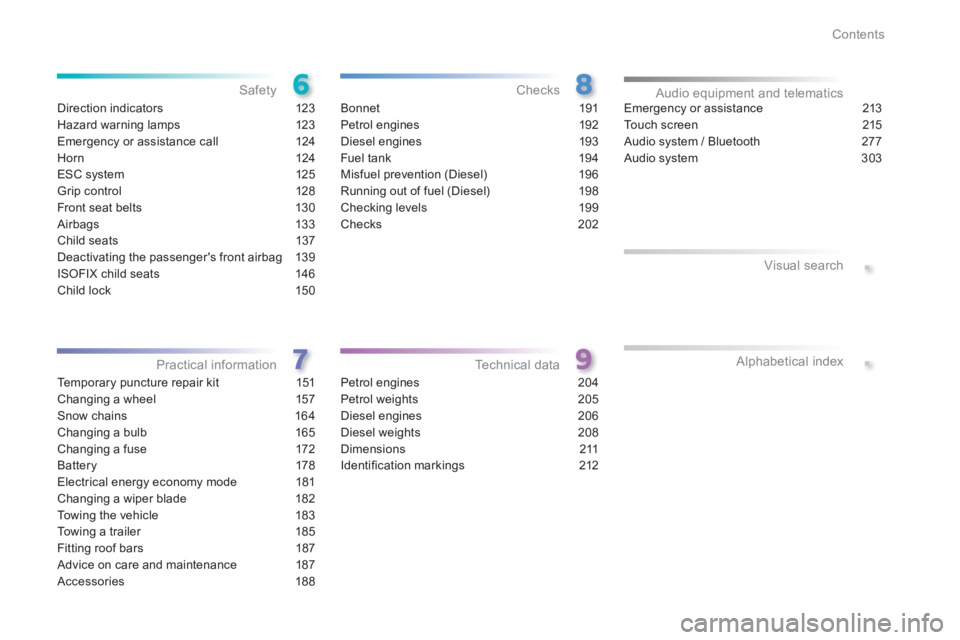
.
.
Contents
Direction indicators 123
Hazard warning lamps 123
Emergency or assistance call 124
H or n 124
ESC system 125
Grip control 128
Front seat belts 130
Airbags 133
Child seats 137
Deactivating the passenger's front airbag 139
ISOFIX child seats 146
Child lock 150
Safety
Temporary puncture repair kit 151
Changing a wheel 157
Snow chains 164
Changing a bulb 165
Changing a fuse 172
Battery 178
Electrical energy economy mode 181
Changing a wiper blade 182
Towing the vehicle 183
Towing a trailer 185
Fitting roof bars 187
Advice on care and maintenance 187
Accessories 188
Practical information
Bonnet 191
Petrol engines 192
Diesel engines 193
Fuel tank 194
Misfuel prevention (Diesel) 196
Running out of fuel (Diesel) 198
Checking levels 199
Checks 202
Checks
Petrol engines 204
Petrol weights 205
Diesel engines 206
Diesel weights 208
Dimensions 211
Identifi cation markings 212
Technical data
Emergency or assistance 213
Touch screen 215
Audio system / Bluetooth 277
Audio system 303
Audio equipment and telematics
Visual search
Alphabetical index
Page 15 of 336
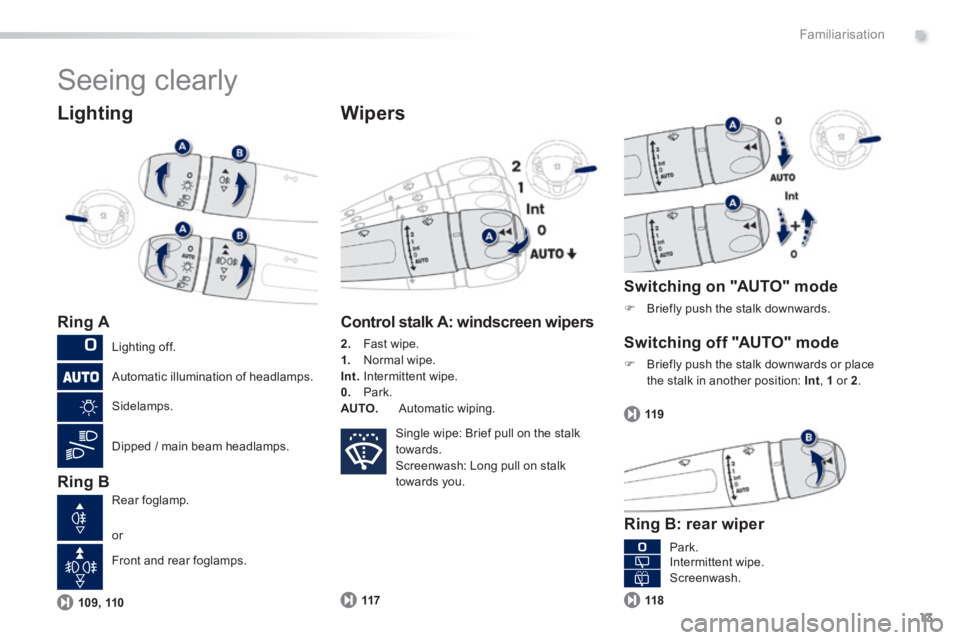
.
13109, 110117
119
118
Familiarisation
Seeing clearly
Lighting
Ring A
Ring B
Wipers
Control stalk A: windscreen wipers
2. Fast wipe. 1. Normal wipe. Int. Intermittent wipe. 0. Park. AUTO. Automatic wiping.
Switching on "AUTO" mode
Briefly push the stalk downwards.
Switching off "AUTO" mode
Briefly push the stalk downwards or place the stalk in another position: Int, 1 or 2.
Ring B: rear wiper
Lighting off.
Automatic illumination of headlamps.
Sidelamps.
Dipped / main beam headlamps.
Rear foglamp.
Park. Intermittent wipe. Screenwash.
or
Front and rear foglamps.
Single wipe: Brief pull on the stalk towards. Screenwash: Long pull on stalk towards you.
Page 21 of 336
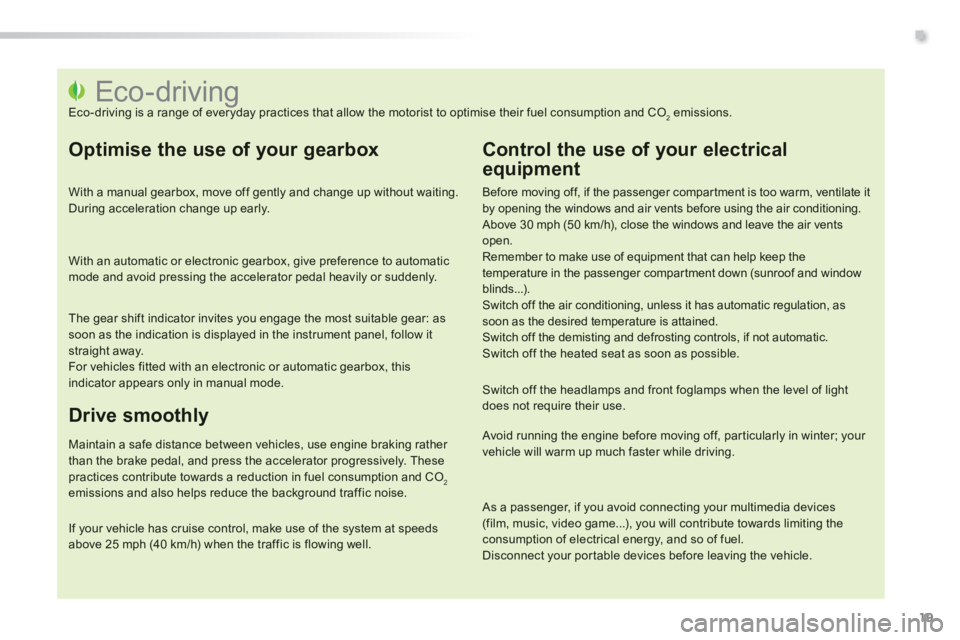
.
19
Eco-driving Eco-driving is a range of everyday practices that allow the motorist to optimise their fuel consumption and CO2 emissions.
Optimise the use of your gearbox
With a manual gearbox, move off gently and change up without waiting. During acceleration change up early.
With an automatic or electronic gearbox, give preference to automatic mode and avoid pressing the accelerator pedal heavily or suddenly.
The gear shift indicator invites you engage the most suitable gear: as soon as the indication is displayed in the instrument panel, follow it straight away. For vehicles fitted with an electronic or automatic gearbox, this indicator appears only in manual mode.
Drive smoothly
Maintain a safe distance between vehicles, use engine braking rather than the brake pedal, and press the accelerator progressively. These practices contribute towards a reduction in fuel consumption and CO2emissions and also helps reduce the background traffic noise.
If your vehicle has cruise control, make use of the system at speeds above 25 mph (40 km/h) when the traffic is flowing well.
Control the use of your electrical
equipment
Before moving off, if the passenger compartment is too warm, ventilate it by opening the windows and air vents before using the air conditioning. Above 30 mph (50 km/h), close the windows and leave the air vents open. Remember to make use of equipment that can help keep the temperature in the passenger compartment down (sunroof and window blinds...). Switch off the air conditioning, unless it has automatic regulation, as soon as the desired temperature is attained. Switch off the demisting and defrosting controls, if not automatic. Switch off the heated seat as soon as possible.
Switch off the headlamps and front foglamps when the level of light does not require their use.
Avoid running the engine before moving off, particularly in winter; your vehicle will warm up much faster while driving.
As a passenger, if you avoid connecting your multimedia devices (film, music, video game...), you will contribute towards limiting the
consumption of electrical energy, and so of fuel. Disconnect your portable devices before leaving the vehicle.
Page 26 of 336
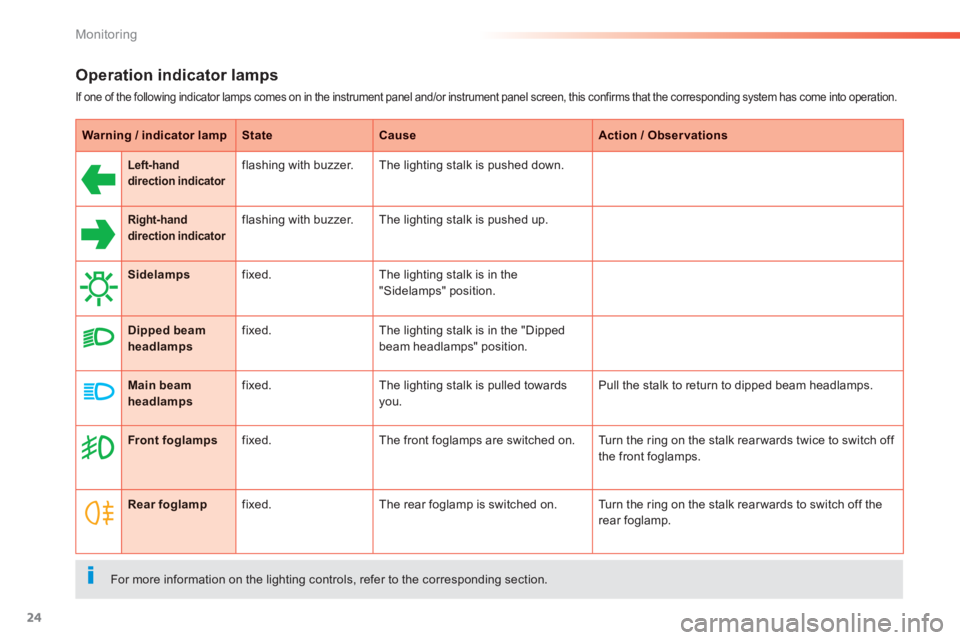
24
Monitoring
Operation indicator lamps
If one of the following indicator lamps comes on in the instrument panel and/or instrument panel screen, this confirms that the corresponding system has come into operation.
Warning / indicator lampStateCauseAction / Observations
Left-hand direction indicatorr r flashing with buzzer. The lighting stalk is pushed down.
Right-hand
direction indicatordirection indicator direction indicator
flashing with buzzer. The lighting stalk is pushed up.
Sidelamps fixed. The lighting stalk is in the "Sidelamps" position.
Dipped beam headlamps fixed. The lighting stalk is in the "Dipped beam headlamps" position.
Main beam headlamps fixed. The lighting stalk is pulled towards you. Pull the stalk to return to dipped beam headlamps.
Front foglamps fixed. The front foglamps are switched on. Turn the ring on the stalk rear wards twice to switch off the front foglamps.
Rear foglamp fixed. The rear foglamp is switched on. Turn the ring on the stalk rear wards to switch off the rear foglamp.
For more information on the lighting controls, refer to the corresponding section.
Page 47 of 336
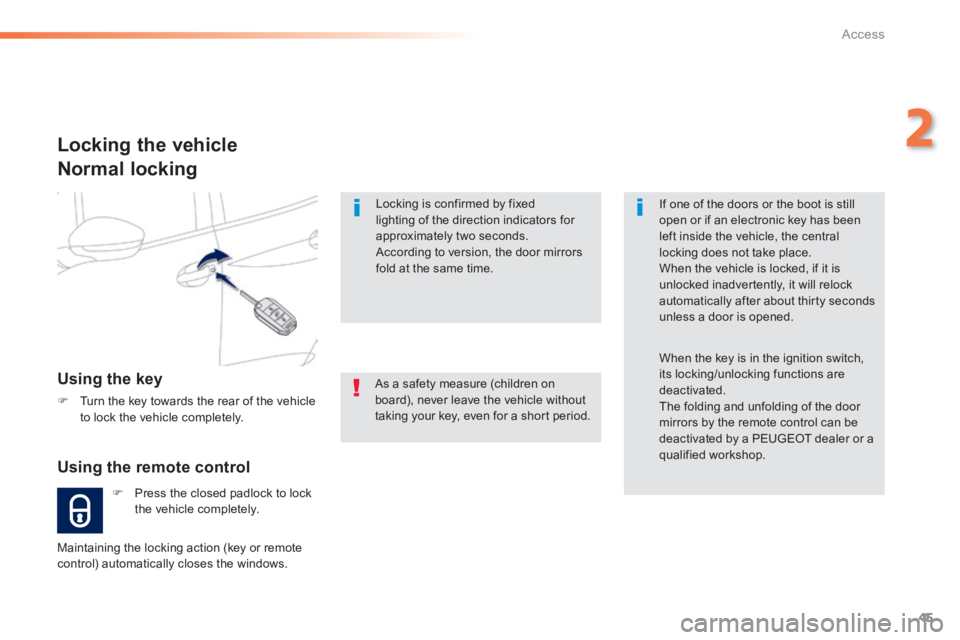
45
2
Access
Locking is confirmed by fixed lighting of the direction indicators for approximately two seconds. According to version, the door mirrors fold at the same time.
As a safety measure (children on board), never leave the vehicle without taking your key, even for a short period.
Locking the vehicle
Normal locking
Using the remote control
Press the closed padlock to lock the vehicle completely.
Using the key
Turn the key towards the rear of the vehicle to lock the vehicle completely.
Maintaining the locking action (key or remote control) automatically closes the windows.
If one of the doors or the boot is still open or if an electronic key has been left inside the vehicle, the central locking does not take place. When the vehicle is locked, if it is unlocked inadvertently, it will relock automatically after about thirty seconds unless a door is opened.
When the key is in the ignition switch, its locking/unlocking functions are deactivated. The folding and unfolding of the door mirrors by the remote control can be
deactivated by a PEUGEOT dealer or a qualified workshop.
Page 51 of 336
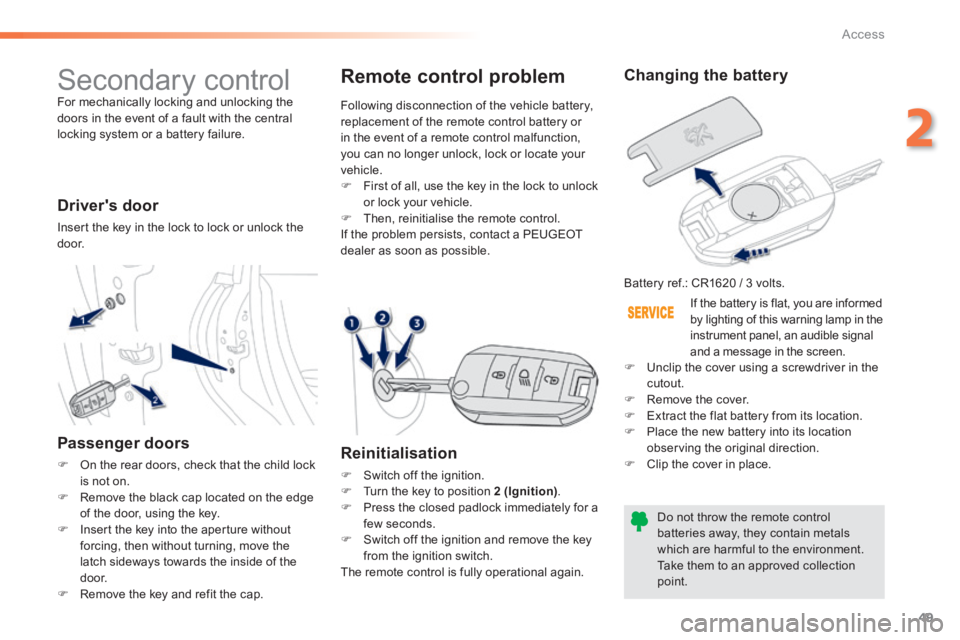
49
2
Access
Secondary control For mechanically locking and unlocking the doors in the event of a fault with the central locking system or a battery failure.
Driver's door
Insert the key in the lock to lock or unlock the d o o r.
Passenger doors
On the rear doors, check that the child lock is not on. Remove the black cap located on the edge of the door, using the key. Insert the key into the aperture without
forcing, then without turning, move the latch sideways towards the inside of the d o o r. Remove the key and refit the cap.
Changing the battery
Battery ref.: CR1620 / 3 volts.
Do not throw the remote control batteries away, they contain metals which are harmful to the environment. Take them to an approved collection point.
Remote control problem
Reinitialisation
Switch off the ignition. Turn the key to position 2 (Ignition) . Press the closed padlock immediately for a few seconds. Switch off the ignition and remove the key from the ignition switch. The remote control is fully operational again.
Following disconnection of the vehicle battery, replacement of the remote control battery or in the event of a remote control malfunction, you can no longer unlock, lock or locate your vehicle. First of all, use the key in the lock to unlock or lock your vehicle. Then, reinitialise the remote control.
If the problem persists, contact a PEUGEOT dealer as soon as possible.
If the battery is flat, you are informed by lighting of this warning lamp in the instrument panel, an audible signal and a message in the screen. Unclip the cover using a screwdriver in the cutout. Remove the cover. Extract the flat battery from its location.
Place the new battery into its location observing the original direction. Clip the cover in place.
Page 58 of 336
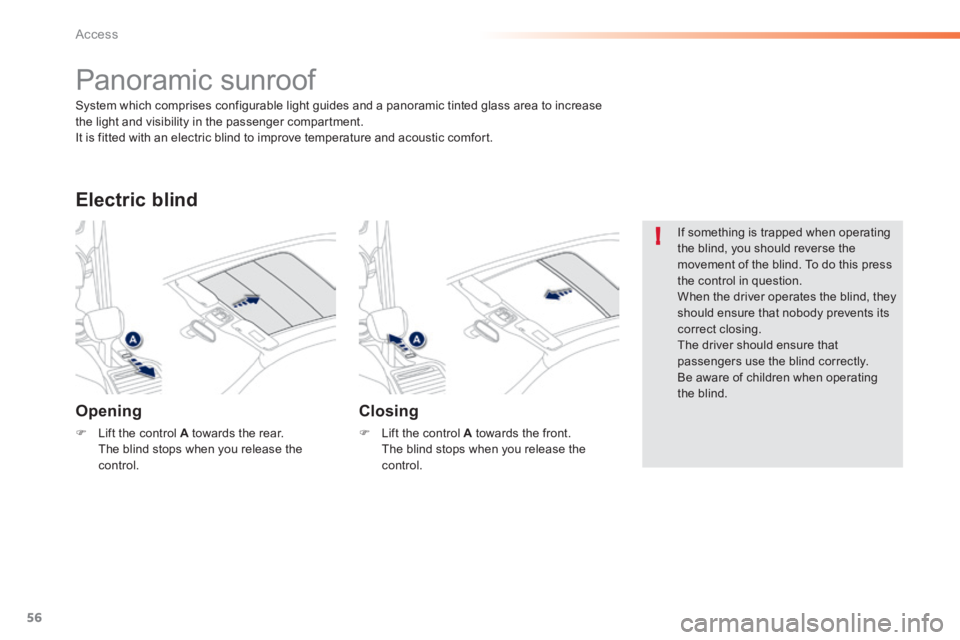
56
!
Access
Panoramic sunroof
Opening
Lift the control A towards the rear. The blind stops when you release the control.
Electric blind
Closing
Lift the control A towards the front. The blind stops when you release the control.
If something is trapped when operating the blind, you should reverse the movement of the blind. To do this press the control in question. When the driver operates the blind, they should ensure that nobody prevents its correct closing. The driver should ensure that passengers use the blind correctly. Be aware of children when operating the blind.
System which comprises configurable light guides and a panoramic tinted glass area to increase the light and visibility in the passenger compartment. It is fitted with an electric blind to improve temperature and acoustic comfort.
Page 62 of 336
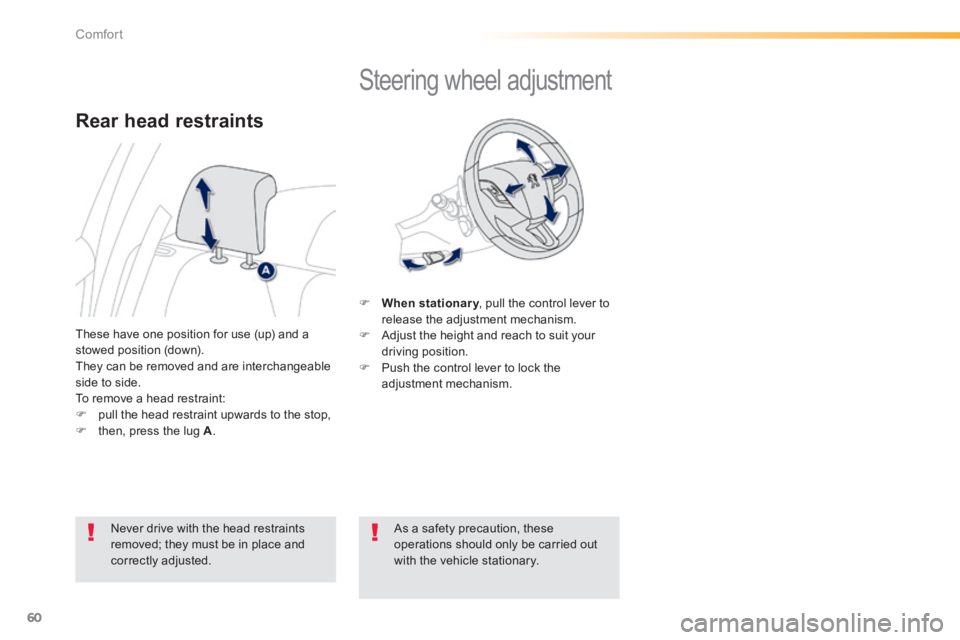
60
Comfort
Steering wheel adjustment
When stationary , pull the control lever to When stationary , pull the control lever to When stationaryrelease the adjustment mechanism. Adjust the height and reach to suit your driving position. Push the control lever to lock the adjustment mechanism.
As a safety precaution, these operations should only be carried out with the vehicle stationary.
These have one position for use (up) and a stowed position (down). They can be removed and are interchangeable side to side. To remove a head restraint: pull the head restraint upwards to the stop,
then, press the lug A .
Rear head restraints
Never drive with the head restraints removed; they must be in place and correctly adjusted.
Page 66 of 336

64
Comfort
In order for these systems to be fully effective, follow the operation and maintenance guidelines below: To obtain an even air distribution, take care not to obstruct the exterior air intake grilles located at the base of the windscreen, the nozzles, the vents and the air outlets, as well as the air extractor located in the boot. Do not cover the sunshine sensor, located on the dashboard; this is used for regulation of the air conditioning system. Operate the air conditioning system for at least 5 to 10 minutes, once or twice a month to keep it in per fect working order. Ensure that the passenger compartment filter is in good condition and have the filter elements replaced regularly. We recommend the use of a combined passenger compartment filter. Thanks to its special active additive, it contributes to the purification of the air breathed by the occupants and the cleanliness of the passenger compartment (reduction of allergic symptoms, bad odours and greasy deposits). To ensure correct operation of the air conditioning system, you are also advised to have it checked regularly as recommended in the warranty and maintenance record. If the system does not produce cold air, switch it off and contact a PEUGEOT dealer or a qualified workshop. When towing the maximum load on a steep gradient in high temperatures, switching off the air conditioning increases the available engine power and so improves the towing ability.
Recommendations for ventilation and air conditioning
If after an extended stop in sunshine, the interior temperature is very high, first ventilate the passenger compartment for a few moments. Put the air flow control at a setting high enough to quickly change the air in the passenger compartment.
The air conditioning system does not contain chlorine and does not present any danger to the ozone layer.
The condensation created by the air conditioning results in a discharge of water under the vehicle which is per fectly normal.
Stop & Start
The heating and air conditioning systems only work when the engine is running. To maintain a comfortable temperature in the passenger compartment, you can temporarily deactivate the Stop & Start system (see the corresponding section).
Page 71 of 336
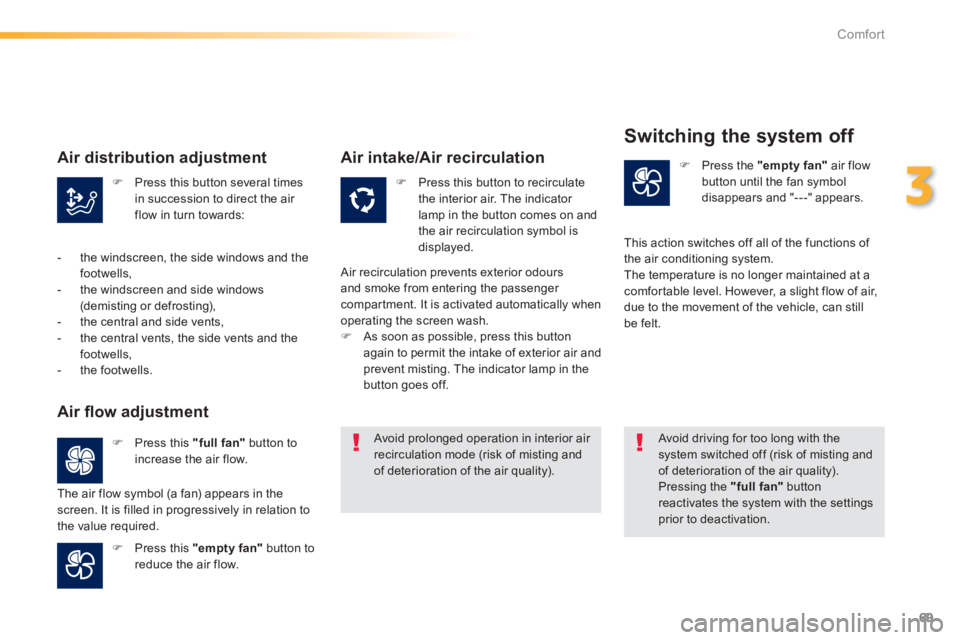
69
3
Comfort
Press this button several times in succession to direct the air flow in turn towards:
Press this button to recirculate the interior air. The indicator lamp in the button comes on and the air recirculation symbol is displayed.
Press the "empty fan" air flow button until the fan symbol disappears and "---" appears.
Press this "full fan" button to increase the air flow.
Press this "empty fan" button to reduce the air flow.
Avoid prolonged operation in interior air recirculation mode (risk of misting and of deterioration of the air quality).
Avoid driving for too long with the system switched off (risk of misting and of deterioration of the air quality). Pressing the "full fan" button reactivates the system with the settings prior to deactivation.
Air distribution adjustment
- the windscreen, the side windows and the footwells, - the windscreen and side windows (demisting or defrosting), - the central and side vents, - the central vents, the side vents and the footwells, - the footwells.
Air fl ow adjustment
The air flow symbol (a fan) appears in the screen. It is filled in progressively in relation to the value required.
Air intake/Air recirculation
Air recirculation prevents exterior odours and smoke from entering the passenger compartment. It is activated automatically when operating the screen wash. As soon as possible, press this button again to permit the intake of exterior air and prevent misting. The indicator lamp in the button goes off.
Switching the system off
This action switches off all of the functions of the air conditioning system. The temperature is no longer maintained at a comfortable level. However, a slight flow of air, due to the movement of the vehicle, can still be felt.